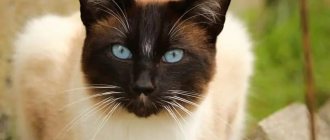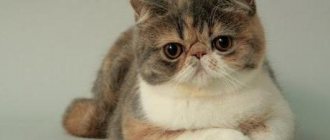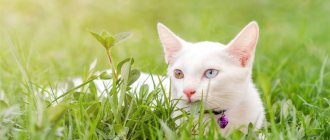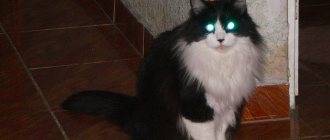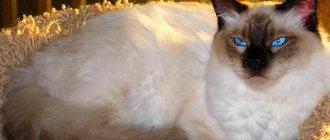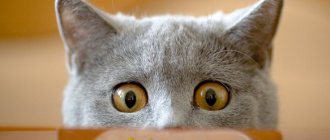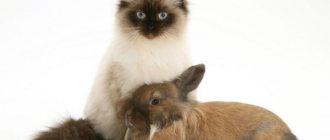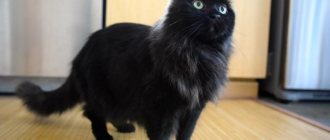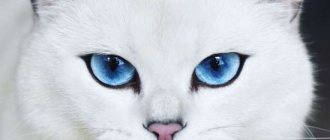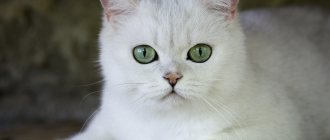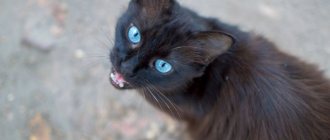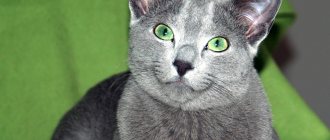The history of flat-faced cats
The domestication of cats occurred about 12 thousand years ago. Back then they were wild animals living in natural conditions. A variety of breeds have begun to appear in the last few centuries. Felinologists were guided by their own vision and created cats with a diverse body structure and coat color.
Cats with a flattened face appeared around 500 BC , at least this fact is attested in written sources and wall paintings. Dutch travelers recorded in their notes that they saw strange cats with fluffy fur at the court of the kings of Persia Cambyses and Darius.
Their attractive appearance made these cats favorites of kings and court nobility . The ancestors of the Persians appeared in Europe in the 16th century. and became loved by the cats of kings. Here cats continued to evolve into the species we see today.
Felinological organizations are responsible for registering new breeds . Thus, out of 200 breeds existing in the world, about 74 breeds have received official recognition. The Persians are just one of them. For example, British cats were previously called shorthaired and were registered as a separate breed only in 1930.
In the 1920s and 1930s in the United States and Sweden, breeders began crossing Siamese and Persian cats. This is how the Himalayan cat appeared. But only in 1980 the breed was officially registered.
In the 60s the 20th century, the Persian and the American Shorthair cat were crossed in the USA. The new breed is called exotic. At first, Murkas frightened breeders with their strange appearance, but nevertheless, the breed became widespread in the USA and other countries of the world. Exotics were officially registered in the 80s.
Scottish cats also have a slightly flattened face, and this breed appeared quite unexpectedly. In the 60s, on a Scottish farm, a cat Susie was born with a gene mutation, which manifested itself in the form of a brachycephalic skull shape and forward-curved ears. At that time, there were no pets with such abnormalities in Scotland, so Susie’s offspring were crossed with the “British”. As a result, it was possible to develop a new breed, which was named after the place of residence of the ancestor.
Scientists explain the unusual shape of the Ford as a genetic deviation . In scientific circles it is called “brachycephaly,” which is translated from Latin as “short head.” In brachycephals, the length of the head is 80% of the width of the skull.
There is another version , according to which the cat inherited this shape of the skull from the Pallas cat. However, the version has no scientific confirmation.
On a note! Breeders worked hard to fix brachycephaly and selected for crossing those individuals whose flattened muzzle was a distinctive feature.
Cat breeds with a flattened face: description and care features
The ancestors of brachycephalic breeds are cats that lived at the court of the Persian king Darius. A genetic mutation made the furry pet funny, and this is precisely the quality of cats that is valued by humans. Felinologists believe that Persian cats descended from the wild cat Manul. Breeders fixed the features of the skull and developed several brachycephalic breeds.
Anatomical features predispose them to respiratory diseases: cats have trouble breathing, so they snore in their sleep and slurp while eating. Brachycephals are susceptible to respiratory diseases and allergies, and do not tolerate temperature changes and drafts. The risk of getting sick increases with age. Older cats are prone to obesity, which leads to shortness of breath and other respiratory pathologies.
Short-faced cats are the most picky eaters. Brachycephalics have sensitive digestion, so they should not be treated to human treats. They do not tolerate ready-made economy class meals well. In short-snouted animals, the lacrimal glands are poorly protected from the influence of environmental factors. If you don't take care of your eyes, conjunctivitis develops.
Pets with a non-standard skull structure need special care for their ears. They are predisposed to the accumulation of sulfur. If you do not clean regularly, otitis media develops. Long-haired brachycephals are prone to matting. Short-faced cats are excellent companions for residents of high-rise buildings. They don't walk outside, so their claws don't get worn down. If you don't take care of the scratching post in time, or don't trim the claws, the furniture will be torn.
Brachycephalics feel uncomfortable in the yard and most often suffer defeat in clashes with yard cats. Short-faced cats are loved for their unusual appearance and good-natured disposition. However, brachycephals require special care.
Be sure to read:
Anatolian cat breed: description, character, photo, price
Persian cat
Persian cats are characterized by the following features:
- short legs;
- powerful, muscular body;
- spherical head;
- small flat nose;
- extremely fluffy tail;
- large bulging eyes.
The average live weight of adult pets reaches 7 kg. The colors of Persians are mostly light, but there are no dominant colors. Persians are couch potatoes. Prone to obesity.
Felinologists distinguish the following intra-breed types:
- Aristocratic or European. It is distinguished by large erect ears and an upturned nose.
- Extreme or American: raised nose. concave, located at the same level with the eyes. Small ears are lowered, eyes are very large.
- Classic or British - the straight nose is located below the eyes, the coat is very long and silky.
Persians do not bother their owners with obsessive meowing and are not prone to aggression.
Exotic
The shortest-snouted breed of all brachycephals. Obtained by crossing a Persian and an American Shorthair. The eyes are huge and located very close to each other. The paws are very powerful, the body is tightly built, and the live weight exceeds 8 kg. The fur is fluffy, but not long; the pet resembles a teddy bear in appearance.
Exotic cats come in a variety of colors. If it were not for the length of the coat, exotics could be confused with extreme Persians. Animals are peaceful, not prone to aggression, and get along with other pets.
Himalayan cat
The first Himalayans were obtained by crossing Persians and Siamese. Hybrids combine characteristics of both breeds. Not all felinological organizations recognize mestizos as an independent breed. However, Himalayan cats are popular because of their unusual appearance and good-natured disposition.
Cats got long hair from Persians and blue eyes from Siamese. The size of the animals is average - about 5 kg. The muzzle, like that of Siamese cats, is dark, and the tone of the body is light. Children adore beautiful kitties: they endure being squeezed without complaint and are not too heavy.
Himalayans are not prone to aggression. Such cats should not appear in the yard: they will be beaten. There are no Himalayan mousecatchers: they consider it a more worthy occupation to curl up in a ball at the feet of their mistress and purr quietly.
Be sure to read:
Cat with tassels on ears: breed, what is their feature, characteristics and description, care and maintenance
British Shorthair
British cats cannot be confused with anyone else.
Despite the variety of colors, the British have specific characteristics:
- short hair;
- yellow eyes;
- rounded muzzle with lowered cheeks
- short tail.
Britons are larger than Himalayans, but slightly smaller than Persians, with an average live weight of 6 kg. It is characteristic that among British cats there is a relatively high percentage of turtles, animals of black, white and red color.
The British live up to their name: they behave calmly, do not damage furniture, and are not prone to aggression. However, you should not squeeze them too hard: they may scratch them. Britons should not be treated to human delicacies: they are prone to allergies, digestive disorders and obesity.
You should not feed your pet soft food: the specific structure of the skull predisposes it to gingivitis and the deposition of tartar. Therefore, it is necessary to purchase granules that help cleanse teeth of plaque. Spontaneous selection has led to the appearance of animals with malocclusion and heart disease. Therefore, kittens should be purchased from breeders with an impeccable reputation.
Scottish fold cats
The breed was developed in the twentieth century. Characteristic features: long and powerful paws, short hair. The live weight of cats reaches 7 kg. The head is round, the neck and chest are intensely muscled, the ears are tilted forward and down. The flatness of the muzzle is less pronounced compared to Persians or exotics. Cats of a single color are more common, but there are also stripes.
The Scots do not require the same care as the British or exotics. Kittens are playful, but adults are sedate.
Wild cat manul
The wild cat is considered the ancestor of the Persians. The animal lives in Central Asia. The dimensions of the mangul are the same as those of a domestic mongrel cat. The color is striped because the hunter needs to camouflage. Manguls are classified as animals listed in the Red Book.
Pallas cat - a wild cat with a flattened muzzle Not only among domestic cat breeds there are representatives of unusual species with a flattened muzzle. Among wild cats, there is one species that also has a non-standard skull shape and an upturned nose - this is the Pallas cat. The habitat of the Pallas's cat is the countries of Central Asia.
Be sure to read:
Which cat breeds are better at catching mice?
The animal is no larger in size than an ordinary domestic cat, but is distinguished by more “predatory” characteristics: a massive body; squatness of the body; very thick fur; flat skull with powerful jaws. Pallas' cats are characterized by only one type of color - striped, since in the wild it is necessary to camouflage for a successful hunt. Pallas' cats as a species are listed in the Red Book. The flattened shape of the head helps the wild cat hold its prey more securely.
Advantages and disadvantages
Cats with flattened faces look charming and have a number of undeniable advantages :
- Their original and interesting appearance will not leave anyone indifferent. Even with the diversity of cat breeds, brachycephals attract attention.
- Their jaws are stronger than those of cats with a classic muzzle structure.
- Cats are endowed with an affectionate and friendly character . They like to impose themselves and behave with restraint.
The disadvantages relate mainly to physiological nuances:
- For animals you need to select special bowls from which they can get water and food without any problems.
- Cats with a strongly flattened muzzle snore and snort in their sleep . This feature amuses some owners, irritates others.
- Shortened tear ducts and the specific shape of the nose cause excessive tearing and mucus production, which is why some animals experience severe stress.
- Some cats with a similar skull structure cannot feed on their own. Their owners spoon-feed them and care for them like babies.
- Animals suffer from impaired thermoregulation function due to short nasal passages; they have difficulty withstanding low air temperatures, and therefore often suffer from infectious diseases.
- Cats with a flattened nose are more likely to suffer from allergies than others .
Despite all the shortcomings of this type of cat, the popularity of these animals does not decrease. Proper care and following your veterinarian's recommendations will minimize problems that may arise.
Cat breeds with flat faces
Every year, the CFA Cat Fanciers Association publishes rankings of the most popular cats. The leaders invariably remain cats with flattened faces.
Representatives of each breed are endowed with distinctive features, despite the fact that the shape of the muzzle is almost the same.
Persian
"Persian" - a breed of cats with a flattened muzzle is considered one of the oldest in the world . The history of its development and formation remains to some extent unknown, but most felinologists are of the opinion that the breed originates from Persia. Nowadays it is the territory of Iran and Turkey.
The breed standard has changed slightly during its existence.
Modern Persians look like this:
- massive build;
- developed muscles;
- short legs;
- large spherical head;
- small upturned nose;
- wide-set ears;
- large round eyes;
- bushy tail.
The weight of males is 5-8 kg , females 3-5 kg.
The most common colors : beige, white, gray. The breed standard includes about 100 different colors.
Breeders distinguish three varieties of the breed :
- Extreme - American subspecies with a raised tip of the nose at eye level. The ears are small and drooping, the eyes are round, like saucers.
- Aristocratic or European - a subspecies close to the classic version. The brachycephalic shape of the skull is little noticeable, the muzzle is slightly flattened, and the nose is turned up. The ears are large and straight.
- Classic or British is a subspecies characterized by a straight nose located just below eye level. These cats have luxurious, long hair.
The Persian cat is called a “couch cat” because most of the time she sleeps peacefully in a cozy corner . “Persians” are very well-mannered animals, so owners should not worry about damaged property. Cats are trainable, quite pliable and not picky. Their calm disposition makes them ideal pets for families with children.
Interesting. Queen Victoria kept two blue Persians at court, and Marilyn Monroe had a white Persian cat named Mitsu.
Himalayan
The Himalayan cat is a direct descendant of the Persian, a breed of cat with large eyes and a flattened muzzle . A Siamese cat also took part in the breeding.
Distinctive features of the breed:
- sky blue eyes;
- dark muzzle on a light background (color point);
- pubescent coat;
- short legs;
- large body.
The Himalayans are just as lazy creatures as the Persians. They like to sleep on a soft pillow or sofa most of the time and only occasionally give in to children's persuasion to play with a candy wrapper.
Cats have a calm and balanced disposition . Owners of the breed note that their pets are as apathetic as possible and allow themselves to be cuddled endlessly. Himalayan cats are infinitely devoted to their owners, they love to follow on their heels, bask on their laps and purr.
Representatives of the breed try to avoid emotional shocks, do not like to play pranks , and lead a measured lifestyle. They find it difficult to cope with a change of place of residence and have difficulty adapting to a new place.
Exotic
The exotic is the owner of the most flattened muzzle among its relatives , the result of a merger of the Persian and American shorthair cats.
Distinctive features of the breed:
- large, close-set eyes;
- soft fur;
- short but strong legs;
- wide chest;
- large sizes;
- Various colors - white to black.
The appearance of a flat-faced exotic cat is in harmony with his character. He is soft, flexible, not prone to aggression, and rarely shows dissatisfaction .
Representatives of this breed are more active and inquisitive than Persians. But if the owner encourages laziness and overeating, the pet will turn into a fluffy pillow that will only show signs of life when it’s lunch time.
Reference. Exotics like to sleep on concrete or tiled floors, which is associated with overheating of the body.
Scottish
The Scottish cat is a sweet and affectionate creature with an attractive appearance and docile character .
Distinctive features of the breed:
- rounded head shape;
- powerful neck and chest;
- strong long legs;
- drooping ears in the Scottish Fold variety, straight ears in the Scottish Straight;
- large weight (6-7 kg).
By nature, the “Scots” are calm, balanced and flexible, suitable for families with children . They are kind, friendly and loving. Over time, cats select one favorite among family members and show maximum trust, cordiality and affection towards him.
“Scots” are generally not very active, so breeders recommend stimulating physical activity in pets to prevent weight gain.
Scottish Folds have an innate curiosity, sometimes they get a little impudent and pretend that they don’t understand what they are accused of: “Just think, I ate half a ficus, I just wanted to taste it!”
British
There are two varieties of British cats - longhair and shorthair, but they have the same breed characteristics :
- muscular body;
- large paws;
- rounded head;
- wide-set ears;
- tassel at the tip of the tail.
The colors and coat patterns are varied . The most popular is smoky blue. British cats are long-lived and live up to 22-24 years.
“British women” are kind and friendly, wonderful companions for single people and playful friends for children . Cats are smart and quick-witted, they love to watch what is happening. Interest in games does not disappear with age. Animals need human attention, love to be around, and show a keen interest in what the owner is doing. For example, if he is working on a laptop, the cat can climb out onto the table and sit next to him or even lie down on the keyboard.
Manul
The wild cat Pallas is considered the progenitor of all breeds with a flattened muzzle. The animal lives in Central Asia, differs little in size from the average domestic cat, but has “predatory” characteristics :
- massive, squat body;
- short legs;
- thick fur;
- flat skull;
- powerful jaws;
- frown;
- tufts of long hair on the cheeks;
- yellow iris;
- always round pupils, regardless of the brightness of the light;
- light gray and fawn-ocher color, hairs with white tips;
- striped pattern that helps camouflage in the wild.
Reference. Pallas' cats are listed in the Red Books of Russia, China, Kyrgyzstan, Kazakhstan, and Mongolia.
How to draw a cat's head
The cat has a round head with a short muzzle. Its eyes appear large and directed forward, giving the cat excellent depth perception.
Note the large eye sockets and short muzzle of the cat's skull.
Drawing a cat's head from the front step by step
1. Draw a circle with a pencil and divide it in the center with vertical and horizontal lines.
Get 10 free video lessons
Ten free video lessons from the Kalacheva School drawing school are available immediately after registration.
Using promo code REFPART
— 10% discount on all courses with teacher verification until the end of 2022!
Get
2. Add two vertical lines on either side of the center line, dividing the head into three parts.
3. Draw the ears and nose.
4. Add the leading edge of the ears, a triangular nose pad, and an inverted V shape to represent the mouth.
Start adding the top of the eyes. The highest point in oval eyes is located just behind the vertical lines that divide the face into three parts.
5. Finalize the details. Add the pupils and complete the eyes by leaving a dark “tear duct” at the inner corners of the cat's eyes that leads to the nose.
Add strands of hair inside the ears and ear pockets.
Ear pockets are the pinched area on the outer edge of the ears.
Add a line just below the head circumference outline, pointing towards the front where the ears meet the head.
6. Outline the sketch with ink (liner or gel pen), adding nostrils at the same time. Let the ink dry and erase the pencil lines.
Another way to build a cat's head
Notice that there is an almost imaginary line running from the inner corner of the ears to the inner corner of the eyes and down to the outer corner of the nose pad. These (partially) imaginary lines create a space between the cat's ears, eyes and nose that narrows as it flows toward the nose pad. Keep this in mind when drawing a cat's face from any angle.
Drawing a cat's head from the side step by step
1. Start with a circle and lines in the center. Then divide the left side of the circle into two equal parts and add a third line at the same distance to the left of the circle.
2. Draw a shape that resembles an upside-down V or a swoosh to represent the nose, tear duct, and top of the eye. Draw a curved line to represent the mouth, making sure the corner of the mouth matches fairly closely to the highest point at the top of the eye. Add the nearest ear and its base.
3. Use a V-shaped line to complete the eye. The outline of the eyeball should curve outward (forward, to the left in this picture) to indicate its rounded shape as it protrudes from the socket. The lower eyelid should tilt upward to meet the outer corner of the eye.
Add a nostril and a line to represent the outer and inner parts of the ear. Continue a line from the outer corner of the eye down the cheek. Draw the far ear.
4. Draw the pupil and shade the tear duct. Indicate the front "cheek" or bulge under the eye. This is where a piece of bone protrudes and wraps around the bottom of the eye socket, protecting the eyeball. Above the eye, show the cat's "forehead" (and where the whiskers attach).
Draw long hairs inside the nearest ear, which are attached to the inside of the front edge and swept back. Finish the ears by adding an ear pocket visible on the nearest ear.
5. Complete the drawing with pencil or ink.
Draw the cat's head from a three-quarter (3/4) perspective
Now let's draw a more three-dimensional portrait of the cat when its head is turned towards us by about 45 degrees.
1. Draw a circle with vertical and horizontal lines that meet where the center of the muzzle will be. Take the "+" shape from the previous drawings, but turn it at a three-quarter angle.
2. Add a circle for the base of the ear. Draw the nose. Note that the nose (and muzzle) does not extend far beyond the circle of the head.
3. Add the ears and eyes, noting that the eyes are slightly wider than the top plane of the nose underneath them.
4. The dotted lines in the picture below show how the top and bottom edges of the eyes line up, even at this angle. Continue drawing the eyes, curving the outline down and toward the nose on the far eye. Add the inner corner of the close eye. Also add the outline of the cat's face and chin.
Add a line just inside the outline of the cat's closest ear to indicate the rim.
5. Complete the contours of the cat's eyes by sharply lifting the bottom edge up to meet the outer corner of the eye.
Add one visible nostril and finish with a cat's mouth. Add fur to the cat's ears and draw a line connecting the inner corners of the two ears. Continue the line to the farthest ear, defining its inner and outer sides. Add an air pocket (in front of the main rim at this angle).
6. Start drawing the fur. Draw the cat's pupils. Notice that the pupil of the farthest eye looks closer to the inner corner of that eye than the pupil of the closer eye. This is due to the angle at which the far eye is viewed.
7. To finish the piece, ink it in, add a mustache, and darken the inner corners of the eyes to define the tear duct area.
How to draw cat eyes
The cat's eyes are large and oval shaped. Their pupils are usually vertical ovals, but they change depending on the lighting. In the dark, the cat's pupils will be large and almost round. In broad daylight, a cat's pupils will be narrow, vertical slits. Cat eye colors range from amber, yellow and green to deep blue.
1. First sketch out the eyes with a pencil.
2. The first application of ink goes over most of the lines already drawn in pencil. You can use a dotted or broken line to show the texture or shades of the fur. The thickest and most continuous lines are used to draw the eyelids and tear duct areas.
3. At this point, use very short, dotted strokes to shade the eyeball under the upper eyelids. Also shade the areas along the tear duct. Define the fur using quick strokes.
4. I recommend using a smaller diameter pen or liner to draw fine details on the eye. Using a pointillism technique (filling space with dots), add shading to the eyeballs and subtly define the highlights of the eyes.
Use very short pen strokes to lightly shade the curved edge on each eye. Still using a liner or smaller diameter pen, draw very short strokes throughout the fur to give it volume and depth.
5. To finish the drawing, shade the eyes and tear ducts until you are satisfied with their appearance. Then go over the fur, using longer strokes in some cases and shorter strokes in others, adding variety and depth to the fur.
On the outer edge of the cheek of the farthest eye, draw long hairs protruding from shorter ones. This creates the appearance of longer "guard hairs" emerging from the shorter, fluffier undercoat. Below we will look in more detail at how to draw fur.
Many short strokes drawn very close together provide subtle shading in some areas such as the space between the eyes and behind the outer edge of the eyes.
Drawing a cat's nose
The cat has a small, triangular nose that can be pink or black.
1. First, draw a vertical rectangle and a slightly curved line about a third down from the top of the rectangle.
2. The cat's nose pad is drawn in a shape similar to a heart.
3. Add nostrils and mouth.
4. Finish the drawing with a pen by shading the nostril area and erase the pencil lines.
Cat face and mouth
Cats have many sharp teeth and a tongue like sandpaper.
Take a closer look at some of the shapes of the cat's face in a half-turn. Notice how many shapes flow into one another.
The cat has many whiskers on its face, some above its eyes, and some on its cheeks. Whiskers grow from rows of hair follicles. Most often, cats have four main rows of whiskers, but this number can vary.
Drawing cat ears
Cat ears are triangular. Like dogs, they have ear pockets on the outer edges of their ears.
Fur on ears
At the base of a cat's ears there are strips of fur that run in different directions and can create characteristic ridges and lines in the hair where they meet. One such area of fur is the area in front of the inner corner of the ear. The fur at the beginning of the ear is often thin and tends to stick almost straight out of the skin. By studying cats, you can get an idea of where these spots and ridges are on the cat's head and body and what they look like from all angles.
Ear pocket
An ear pocket is a small, pinched area of jagged skin along the outer edge of the ear. This is common to many animals. If you look at it from a certain angle, you can see an indentation along the contour of the ear.
A Closer Look at a Cat's Ear
Notice the strip of fur running from the inner edge of the ear to the other side. There is a small patch of shorter hair at the inner base of the ear that is sometimes visible. Pay attention whether you always draw it or not.
Features of care and susceptibility to disease
Gene mutations in brachycephalic cats cause breathing problems . Both kittens and adult cats often snore in their sleep and smack their lips while eating. They suffer from upper respiratory tract infections more often than other breeds and experience discomfort associated with increased lacrimation due to their close-set eyes. When you have a cold, the conjunctiva becomes inflamed and purulent discharge is observed.
Flat-faced felines are susceptible to allergic reactions to pollen and dust .
The diet of brachycephals should be balanced and varied . Breeders note that they are extremely demanding on the quality of food and prefer dry or wet premium and super premium food, natural food - poultry, white fish, fresh vegetables and herbs. Animals often have digestive problems, so they should not be fed food from the table, given whole cow's milk, sweets, or smoked meats.
Caring for cats with flat fashion is not burdensome, but requires compliance with a number of rules:
- animals must be protected from frost, drafts and temperature changes;
- feed with premium food;
- clean your eyes daily with alcohol-free wet wipes or cotton pads soaked in clean water or tea leaves;
- Inspect and clean the ears once a week; cleaning ears for folds is especially important;
- Visit your veterinarian regularly to watch for breathing problems that develop in older animals.
These rules will help keep your pets healthy and minimize problems associated with brachycevalia.
